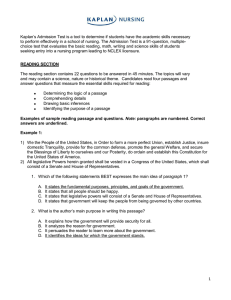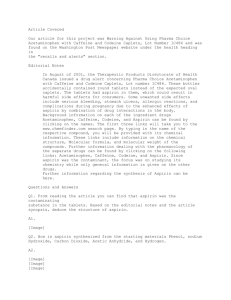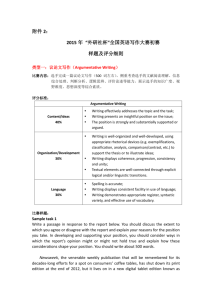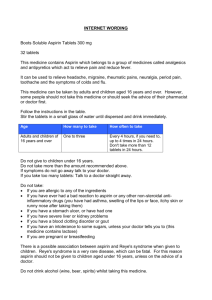a study guide for the Kaplan Admission Exam
advertisement
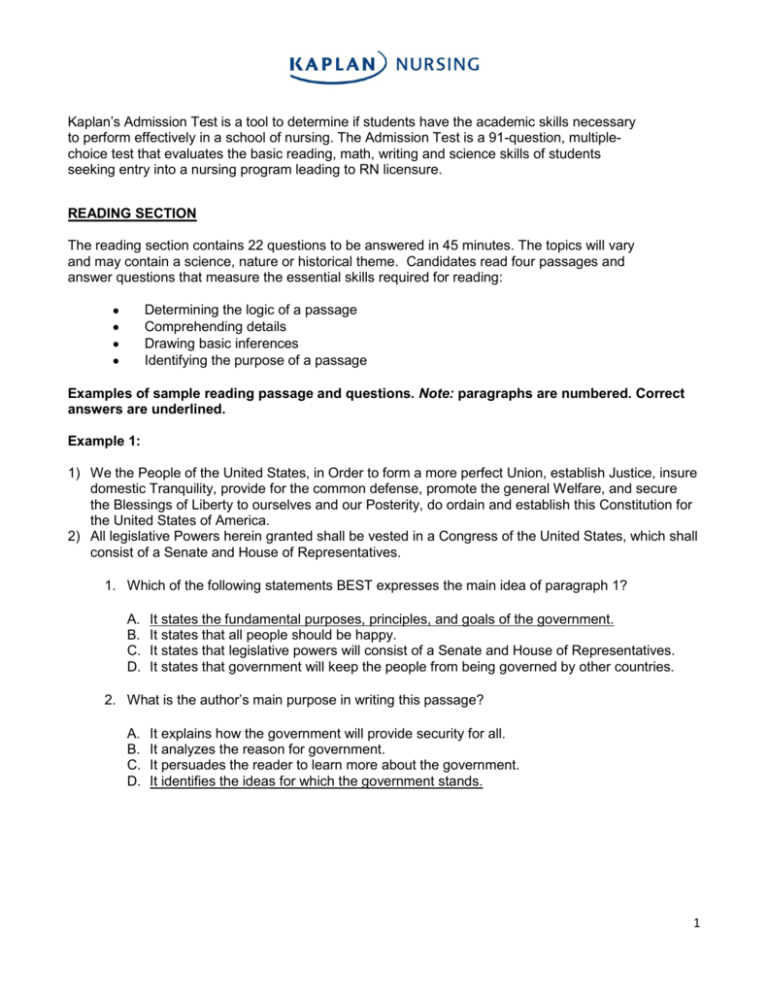
Kaplan’s Admission Test is a tool to determine if students have the academic skills necessary to perform effectively in a school of nursing. The Admission Test is a 91-question, multiplechoice test that evaluates the basic reading, math, writing and science skills of students seeking entry into a nursing program leading to RN licensure. READING SECTION The reading section contains 22 questions to be answered in 45 minutes. The topics will vary and may contain a science, nature or historical theme. Candidates read four passages and answer questions that measure the essential skills required for reading: Determining the logic of a passage Comprehending details Drawing basic inferences Identifying the purpose of a passage Examples of sample reading passage and questions. Note: paragraphs are numbered. Correct answers are underlined. Example 1: 1) We the People of the United States, in Order to form a more perfect Union, establish Justice, insure domestic Tranquility, provide for the common defense, promote the general Welfare, and secure the Blessings of Liberty to ourselves and our Posterity, do ordain and establish this Constitution for the United States of America. 2) All legislative Powers herein granted shall be vested in a Congress of the United States, which shall consist of a Senate and House of Representatives. 1. Which of the following statements BEST expresses the main idea of paragraph 1? A. B. C. D. It states the fundamental purposes, principles, and goals of the government. It states that all people should be happy. It states that legislative powers will consist of a Senate and House of Representatives. It states that government will keep the people from being governed by other countries. 2. What is the author’s main purpose in writing this passage? A. B. C. D. It explains how the government will provide security for all. It analyzes the reason for government. It persuades the reader to learn more about the government. It identifies the ideas for which the government stands. 1 Example 2: Questions 3-4 are based on the following passage. Many mammals instinctively raise their fur when they are cold – a reaction produced by tiny muscles just under the skin that surround hair follicles. When the muscles contract, the hairs stand up, creating an increase in air space under the fur. The air space provides more effective insulation for the mammal’s body, thus allowing it to retain more heat for longer periods of time. Some animals also raise their fur when they are challenged by predators or even other members of their own species. The raised fur makes the animal appear slightly bigger and ideally, more powerful. Interestingly, though devoid of fur, humans still retain this instinct. So, the next time a horror movie gives you “goosebumps”, remember that your skin is following a deep-seated mammalian impulse now rendered obsolete. 3. The “increased air space under the fur” mentioned in the passage serves primarily to: A. Combat cold. B. Intimidate other animals. C. Render goosebumps obsolete. D. Cool overheated predators. 4. Based on the passage, the author would most likely describe “goosebumps” in humans as: A. An unnecessary and unexplained phenomenon. B. A harmful but necessary measure. C. An amusing but dangerous feature. D. A useless but interesting remnant. MATH SECTION The math section contains 28 questions to be answered in 45 minutes. The questions contain basic arithmetic to algebra and are in the form of a basic equation or word problem. The test measures the candidate’s ability to apply mathematical principles in the following areas: Conversions Operations Ratios Word problems Examples of sample math equations. Correct answers are underlined or given after the equations. 1. Which of the following equations is true? A. B. C. D. 500/1500 = 1/2 1/2 + 3/4 – 1/8 = 1 1/8 0.001 = 10% 53.3 + 30.5 – 22.88 = 60.53 2 2. Which of the following equations is true? A. B. C. D. 0.0053 = 53/10000 Ratio of 2 to 3 is the same as 23% 42 divided by 0.123 = 0.341 4/5 divided by 2/3 = 1 2/3 3. If X/5 + 3 = 75, then X equals ______. Answer: X = 360 4. A nurse is to give the liquid medicine 3 times a day. The morning dose is 3/4 ounce, the noon dose is 1/2 ounce and the evening dose is 3/4 ounce. The nurse has 1 ounce of medicine at noon. How much more is needed? Answer: 1 ounce 5. A child is given an allowance of $1.25 per day for chores. The parent says they will increase the allowance by 75 cents per day after a month. What is the percent increase the child receives? Answer: 60% 6. A 6-year-old-child with a congenital heart disorder is admitted with congestive heart failure. Digoxin (Lanoxin) 0.12 mg is ordered for the child. The bottle of Lanoxin contains 0.05 mg of Lanoxin in 1 mL of solution. Which of the following amounts should the nurse administer to the child? A. 1.2 mL B. 2.4 mL C. 3.5 mL D. 4.2 mL 7. The physician orders codeine 60 mg and aspirin X grains. Each codeine tablet contains 15 mg of codeine. Each aspirin tablet contains 325 mg of aspirin. Which of the following should the nurse administer? (Round the number up to the nearest whole number) A. B. C. D. 2 codeine tablets and 4 aspirin tablets 4 codeine tablets and 3 aspirin tablets 4 codeine tablets and 2 aspirin tablets 3 codeine tablets and 3 aspirin tablets WRITING SECTION The writing section contains 21 questions to be answered in 45 minutes. Candidates read nine passages and answer questions that measure the essential skills required for writing: Assessing passage development Assessing paragraph logic Assessing mechanics of writing 3 Examples of sample writing questions. Note each sentence is numbered. Correct answers are underlined. 1 By the time you take the NCLEX-RN® examination, you will be out of nursing school for 1-3 months. 2 Remember that old saying, “What you are not learning, you are forgetting”? 3 Because this is a test about safe and effective nursing care, you must remember all that you can to select correct answers. 4 You must also master exam-style questions. 5 It is essential that you be able to correctly identify what each question is asking. 6 To master test questions, you must practice answering them. 7 We recommend you answer hundreds of exam-style questions, especially at the application level of difficulty. 8 And have a good understanding of nursing content. 9 Memorize facts so you can answer by recall. 1. Which sentence in the last paragraph is missing a subject? A. Sentence 6 B. Sentence 7 C. Sentence 8 D. Sentence 9 2. Which sentence includes an unnecessary word? A. Sentence 2 includes unnecessary word that. B. Sentence 3 includes unnecessary word that. C. Sentence 6 includes unnecessary word test. D. Sentence 7 includes unnecessary word especially. 3. Where is the best place to add this sentence? You must study content that is integrated and organized like the NCLEX-RN® exam. A. Before sentence 2. B. After sentence 3. C. Before sentence 5. D. After sentence 8. SCIENCE SECTION The science section contains 20 questions to be answered in 30 minutes. The test measures the candidate’s knowledge of physiology in the following areas: Cardiovascular system Electrolytes Gastrointestinal system Immune system Neurology Renal system Hematological system Homeostasis Respiratory system Sensory system 4 Examples of sample science questions. Correct answers are underlined. 1. Which statement is true about the transport of oxygen in the lungs? A. It acquires carbon dioxide and removes nitrogen. B. A demand for more oxygen requires an increase in cellular metabolism. C. Diffusion occurs at the bronchioles capillary junctions. D. Increase rate of respirations is controlled by an increased fever. 2. Fluid balance alterations can result from what factors? A. Fluid shifts due to a burn injury. B. High blood levels such as extracellular fluid C. Stimulation of the parasympathetic system. D. The neurological system correcting an excess of a metabolic acid. 3. Which statement is true? A. The large intestine absorbs most nutrients. B. Infection is fought by the somatic nervous system. C. Granulocytes respond quickly to infectious agents. D. Endocrine glands release hormones by active transport. 4. Which of the following is a function of bone? 1. Formation of blood cells 2. Protection of vital organs. 3. Framework for movement. A. 1 only B. 2 only C. 3 only D. 1, 2, and 3 5. The rate of breathing is controlled by involuntary centers in the: A. Cerebrum B. Cerebellum C. Medulla oblongata D. Spinal cord 5
